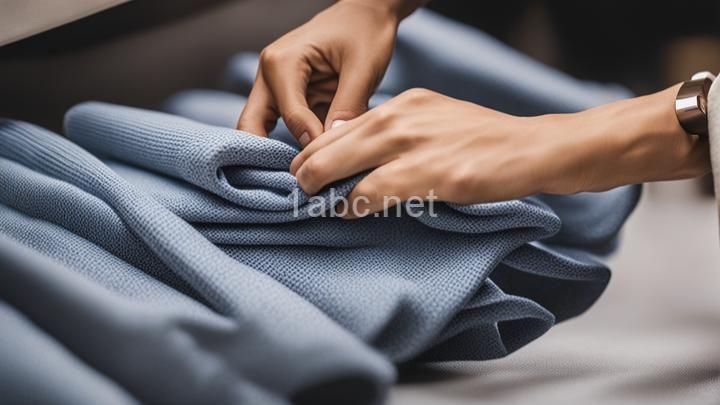Expert Advice: How to Handle and Care for Delicate Fabrics Like a Pro

Introduction:
Hello there, fabric enthusiasts! Today, we're diving into the world of delicate fabrics and sharing some expert advice on how to handle and care for them like a pro. We all have those special garments made from delicate fabrics like silk, lace, and chiffon that require a little extra TLC. By understanding their unique characteristics and following the right care instructions, you can keep them looking beautiful and ensure they last for a long time. So, grab a cup of tea and get ready for some fabric care knowledge!
I. Understanding Delicate Fabrics
Delicate fabrics are those that require special attention due to their fragile nature. They are often made from fine fibers that can easily be damaged if not handled properly. Fabrics like silk, lace, chiffon, and organza fall into this category. These fabrics have a delicate feel and a luxurious appearance, making them a favorite among fashion lovers. However, their delicate nature makes them prone to damage or mishandling if not cared for correctly.
When it comes to delicate fabrics, it's crucial to know their specific care instructions. Each fabric has its own requirements, and following them will help maintain their beauty and integrity. Whether it's handwashing, dry cleaning, or using a gentle cycle in the washing machine, understanding how to care for different delicate fabrics will ensure they remain in pristine condition.
II. Preparing for Care
Before we jump into the actual care process, let's talk about how to prepare for it. One essential step is to read the labels on your garments made from delicate fabrics. These labels provide valuable information about the fabric composition and the recommended care instructions. They may also include care symbols that indicate specific instructions for washing, drying, and ironing.
Understanding these care symbols is essential to avoid any mishaps. You don't want to accidentally shrink your favorite silk blouse, do you? Luckily, these symbols are standardized, and once you know what they mean, you'll be able to decipher them with ease. Look for symbols that represent handwashing, machine washing, dry cleaning, and ironing to ensure you're following the correct care method for your delicate fabrics.
Additionally, when it comes to laundry, it's crucial to sort your delicate fabrics from other items. This prevents potential damage caused by friction or snagging during the washing process. Handwashing delicate fabrics separately or placing them in a mesh laundry bag can also help protect them from getting tangled and damaged in the washing machine.
III. Washing Delicate Fabrics
Now that you're equipped with the knowledge on how to prepare for care, let's dive into the actual washing process for delicate fabrics. Handwashing is often the safest method for delicate fabrics, as it allows you to have full control over the process. To start, fill a clean basin or sink with lukewarm water and add a gentle detergent specifically designed for delicate fabrics.
Gently agitate the water to create a mild soapy solution. Submerge your delicate garment in the water and gently swirl it around. Avoid rubbing or scrubbing forcefully, as this can cause damage to the fabric fibers. Let the garment soak for a few minutes to allow the detergent to work its magic in lifting dirt and impurities. After soaking, rinse the garment thoroughly with clean water until all the soap is gone.
If handwashing isn't your preference or the care label permits, you can also opt for a delicate cycle in the washing machine. Just make sure to use cold water and a gentle detergent. Place your delicate garment in a mesh laundry bag to protect it from becoming entangled with other items. Remember to avoid using harsh chemicals, excessive agitation, or high heat, as these can damage delicate fabrics.
IV. Drying Delicate Fabrics
Once your delicate fabrics are clean and rinsed, it's time to move on to the drying process. Air drying is generally the safest option for delicate fabrics. To do this, gently lay the washed garment flat on a clean towel or drying rack. Avoid wringing or twisting the fabric, as this can lead to stretching or distortion. If you're drying a delicate blouse or dress, you can also hang it on a non-metal hanger away from direct sunlight.
Using a dryer is not recommended for delicate fabrics unless specifically mentioned on the care label. The heat and tumbling motion of the dryer can cause shrinkage, fabric damage, or even color fading. So, it's best to play it safe and stick to air drying whenever possible.
After your delicate fabric is completely dry, check if any reshaping or ironing is necessary. Sometimes, garments can lose their shape during the washing and drying process. If needed, gently reshape the fabric by hand or use a low-heat iron to press out any wrinkles. Always place a pressing cloth between the iron and the fabric to protect it from direct heat.
V. Ironing and Steaming Delicate Fabrics
Ironing delicate fabrics can be a bit tricky, but with the right techniques, you can achieve wrinkle-free perfection. Before you start ironing, check the care label to see if ironing is recommended for the specific fabric. If it is, set your iron to a low heat setting, as high heat can damage delicate fibers.
To protect delicate fabrics from direct contact with the iron, place a pressing cloth, such as a clean cotton fabric or a thin towel, over the fabric. This will act as a barrier and prevent any heat damage. Gently glide the iron over the pressing cloth, being careful not to apply too much pressure. Remember, delicate fabrics are fragile, so treat them with care!
If you're not a fan of ironing or have a fabric that's particularly prone to heat damage, steaming is a fantastic alternative. Steamers are gentle on delicate fabrics and can effectively remove wrinkles without direct contact. Hang your garment on a hanger, and slowly pass the steamer over the fabric, allowing the steam to relax the fibers and release the wrinkles. Steaming is a quick and effective method to freshen up your delicate fabrics.
VI. Storing Delicate Fabrics
Proper storage is crucial to keep your delicate fabrics in pristine condition when they're not in use. Start by folding your garments carefully to prevent wrinkles. If possible, use acid-free tissue paper to stuff the sleeves, bodice, or any areas prone to creasing. This will help maintain their shape and prevent any permanent wrinkles from forming.
When it comes to storing delicate fabrics, it's best to avoid hanging them for extended periods. Hanging can cause stretching or distortion, especially with heavier fabrics like silk. If you do choose to hang delicate garments, use padded or fabric-covered hangers to prevent any damage to the fabric.
To provide an extra layer of protection, consider storing your delicate fabrics in garment bags. These bags help shield your garments from dust, sunlight, and potential discoloration. Plus, they make it easier to organize and locate your delicate pieces when you need them.
Conclusion:
Congratulations! You've now become a pro at handling and caring for delicate fabrics. By understanding the unique characteristics of delicate fabrics and following the specific care instructions for each type, you can ensure that your favorite pieces stay beautiful and last for years to come. Remember, fabric care doesn't have to be daunting. With the right techniques and a little bit of care, you can keep your delicate fabrics looking their best. So, go ahead and pamper your silk blouses, lace dresses, and chiffon skirts – they deserve it! If you have any further questions or concerns, feel free to reach out. Happy fabric care!
FREQUENTLY ASKED QUESTIONS
How do I determine if a fabric is delicate?
To determine if a fabric is delicate, there are a few factors you can consider. First, you can check the care label on the fabric. If it indicates that the fabric requires special care, such as hand washing or dry cleaning, then it is most likely delicate. Additionally, you can examine the fabric itself. Delicate fabrics tend to be lightweight, sheer, or have intricate designs or embellishments. They may also feel more fragile and prone to damage. If you're still unsure, it's always a good idea to do a spot test on a small, inconspicuous area of the fabric to see how it reacts. Remember, delicate fabrics require gentle handling to avoid damage, so it's important to take extra care when washing, drying, and storing them.
What is the best way to wash delicate fabrics?
When it comes to washing delicate fabrics, it's important to take extra care to avoid damaging them. Here are some tips to help you wash your delicate fabrics safely:
-
Read the care label: Before you start washing, always check the care label on the garment. It will provide specific instructions on how to clean the fabric properly.
-
Handwashing: If the care label recommends handwashing, fill a clean basin or sink with lukewarm water and a gentle detergent. Gently agitate the fabric in the water, making sure not to rub or twist it too vigorously. Rinse thoroughly and gently squeeze out excess water.
-
Machine washing: If the care label permits machine washing, use a delicate or gentle cycle with cold water. Place the delicate items in a mesh laundry bag to protect them from getting tangled or stretched during the wash cycle. Use a mild detergent that is specifically formulated for delicate fabrics.
-
Temperature control: Avoid using hot water when washing delicate fabrics, as it can cause shrinkage or damage. Stick to lukewarm or cold water instead.
-
Drying: After washing, gently reshape the garment and lay it flat on a clean towel to air dry. Avoid hanging delicate fabrics, as this can stretch them out of shape. If you're using a dryer, use the lowest heat setting and remove the garment while it's still slightly damp to prevent over-drying.
-
Ironing: If ironing is necessary, use a low heat setting and place a clean cloth between the iron and the fabric to prevent direct contact. Some delicate fabrics may require steam ironing instead of direct heat.
Remember, every fabric is unique, so it's always best to follow the care instructions provided by the manufacturer. By taking these precautions, you can help ensure that your delicate fabrics stay in great condition for longer.
Can delicate fabrics be machine washed?
Yes, delicate fabrics can be machine washed, but it is important to take some precautions. Before tossing them in the washing machine, it is advisable to check the care label on the garment. The care label will provide specific instructions on how to best care for the fabric. If the label allows for machine washing, follow these steps:
-
Sort the laundry: Separate delicate fabrics from heavier or more abrasive items to prevent damage. It's best to wash delicate fabrics together or with similar materials.
-
Use a gentle cycle: Select the delicate or gentle cycle on your washing machine. This setting typically uses slower agitation and shorter wash times, which can help protect delicate fabrics from excessive wear and tear.
-
Choose the right detergent: Opt for a mild detergent specifically designed for delicate fabrics or one that is labeled as gentle or suitable for handwashing. Avoid using bleach or harsh chemicals as they can be too harsh on delicate materials.
-
Use cold water: Washing delicate fabrics in cold water helps to prevent shrinking, color fading, and fabric damage. Cold water is generally gentler on fabrics compared to hot water.
-
Use a laundry bag or pillowcase: For extra protection, place delicate items in a mesh laundry bag or pillowcase before putting them in the washing machine. This helps to minimize friction and reduces the risk of snags or tears.
-
Skip the dryer: Air-drying delicate fabrics is the safest option. Hang them up or lay them flat on a clean towel to dry. Avoid wringing or twisting the fabric, as this can cause stretching or distortion.
It's worth noting that some delicate fabrics may still require handwashing or professional dry cleaning to maintain their integrity. Always refer to the care label for specific instructions. And if you're unsure, it's better to err on the side of caution and choose a gentler method of cleaning.
How should I handle delicate fabrics while ironing?
When it comes to handling delicate fabrics while ironing, there are a few key steps you can follow to ensure that you don't damage or ruin your favorite garments.1. Check the fabric care label: Before ironing any delicate fabric, always check the care label to see if it is suitable for ironing. Some fabrics, like silk or lace, may require special care or even be labeled as "dry clean only". Following the instructions on the label will help you avoid any mishaps.
-
Adjust the iron temperature: Delicate fabrics are more prone to heat damage, so it's important to adjust the iron temperature accordingly. Set your iron to a lower heat setting, usually labeled as "low" or "delicate", to avoid scorching or melting the fabric. If your iron has a steam function, make sure to turn it off as excessive moisture can also harm delicate fabrics.
-
Use a pressing cloth: To provide an extra layer of protection for delicate fabrics, consider using a pressing cloth. This can be a lightweight, clean cotton or muslin fabric that you place between the iron and the garment. The pressing cloth acts as a barrier, preventing direct contact between the iron and the delicate fabric.
-
Iron inside out: Another helpful tip is to iron delicate fabrics inside out. This helps to protect the fabric's surface from direct heat and reduces the risk of any visible marks or shiny spots. Gently press the iron over the fabric without applying too much pressure.
-
Test in an inconspicuous area: If you're unsure about how a particular delicate fabric will react to the iron, it's always a good idea to test it in an inconspicuous area first. Choose a small, hidden section of the garment and iron it following the steps above. If there are no visible signs of damage, you can proceed with ironing the entire garment.
Remember, patience and caution are key when ironing delicate fabrics. Take your time and use gentle, smooth movements to avoid any accidents. By following these guidelines, you can confidently handle delicate fabrics and keep your clothes looking their best.

